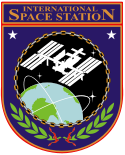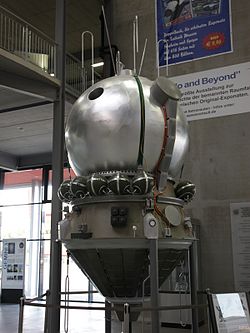STS-98
| STS-98 | |||||
 | |||||
| Uppdrag | 102 | ||||
|---|---|---|---|---|---|
| Rymdfärja | Atlantis (23)[1] | ||||
| NSSDC-ID | 2001-006A[2] | ||||
| Färdens tid | 12 dagar, 21 timmar, 21 minuter | ||||
| Uppskjutning | |||||
| Startplats | Pad 39A vid Kennedy Space Center i Florida | ||||
| Start | 7 februari, 2001, 6:13 p.m. EST | ||||
| Landning | |||||
| Landningsplats | Edwards Air Force Base i Kalifornien | ||||
| Landning | 20 februari, 2001, 3:33 p.m EST | ||||
| Omloppsbana | |||||
| Varv | 202 st[3] | ||||
| Banlutning | 51,6° | ||||
| Sträcka | 8,5 miljoner km | ||||
| Rymdpromenad | |||||
| Antal | 3 st | ||||
| Total tid | 18 timmar, 49 minuter | ||||
| Dockning | |||||
| Rymdstation | ISS | ||||
| Dockning | 9 februari 2001, 16:51 UTC | ||||
| Dockningsport | PMA-3 (Unity, nadir) | ||||
| Urdockning | 16 februari 2001, 14:05 UTC | ||||
| Tid dockad | 6 dagar, 21 timmar, 14 minuter | ||||
| Besättning | |||||
| Befälhavare | Kenneth D. Cockrell (4) | ||||
| Pilot | Mark L. Polansky (1) | ||||
| Uppdragsspecialister | Robert L. Curbeam (2) Thomas D. Jones (4) Marsha S. Ivins (5) | ||||
 | |||||
| Kronologi Rymdfärjeprogrammet | |||||
| |||||
STS-98 var en flygning i det amerikanska rymdfärjeprogrammet till Internationella rymdstationen ISS, med rymdfärjan Atlantis. Den sköts upp från Pad 39A vid Kennedy Space Center i Florida den 7 februari 2001. Efter nästan tretton dagar i omloppsbana runt jorden återinträdde rymdfärjan i jordens atmosfär och landade vid Edwards Air Force Base i Kalifornien.
Flygningens huvudmål var att leverera den amerikanska laboratoriemodulen Destiny till stationen. Atlantis dockade med stationen den 9 februari.
Väckningar
Under Geminiprogrammet började NASA spela musik för besättningar och sedan Apollo 15 har man varje "morgon" väckt besättningen med ett musikstycke, särskilt utvalt antingen för en enskild astronaut eller för de förhållanden som råder.
| Dag | Låt | Artist/Kompositör |
|---|---|---|
| 2 | "Where You At" | Zoot Sims |
| 3 | "Who Let The Dogs Out" | Baha Men |
| 4 | "Girl's Breakdown" | Alison Brown |
| 5 | "An der schönen blauen Donau" | Johann Strauss Jr. |
| 6 | "Fly Me to the Moon" | Frank Sinatra |
| 7 | "For Those About to Rock" | AC/DC |
| 8 | "To the Moon and Back" | Savage Garden |
| 10 | "The Trail We Blaze" | Elton John |
| 11 | "Blue (Da Ba Dee)" | Eiffel 65 |
| 12 | "Fly Away" | Lenny Kravitz |
| 14 | "Should I Stay or Should I Go" | The Clash |
Se även
Referenser
- ^ NASA Space Shuttle Launch Archive Arkiverad 30 augusti 2013 hämtat från the Wayback Machine., läst 28 juli 2016.
- ^ ”NASA Space Science Data Coordinated Archive” (på engelska). NASA. https://nssdc.gsfc.nasa.gov/nmc/spacecraft/display.action?id=2001-006A. Läst 22 mars 2020.
- ^ Manned Astronautics - Figures & Facts Arkiverad 4 mars 2016 hämtat från the Wayback Machine., läst 28 juli 2016.
Externa länkar
 Wikimedia Commons har media som rör STS-98.
Wikimedia Commons har media som rör STS-98.
| ||||||||
| |||||||||||||||||||||||||||||||
| ||||||||||||||||||||||||||||||||
Media som används på denna webbplats
Författare/Upphovsman: Pascal (Flickr user: pasukaru76), Licens: CC0
Vostok spacecraft replica at the Technik Museum Speyer, Germany.
In this illustration, a SpaceX Crew Dragon spacecraft approaches the International Space Station for docking. NASA is partnering with Boeing and SpaceX to build a new generation of human-rated spacecraft capable of taking astronauts to the station and expanding research opportunities in orbit. SpaceX's upcoming Demo-1 flight test is part of NASA’s Commercial Crew Transportation Capability contract with the goal of returning human spaceflight launch capabilities to the United States.
Backdropped by a blue and white Earth, this close-up view features the Soyuz TMA-6 spacecraft approaching the International Space Station (ISS). Onboard the spacecraft are cosmonaut Sergei K. Krikalev, Expedition 11 commander representing Russia's Federal Space Agency; astronaut John L. Phillips, NASA ISS science officer and flight engineer; and European Space Agency (ESA) astronaut Roberto Vittori of Italy. The Soyuz linked to the Pirs Docking Compartment at 9:20 p.m. (CDT) on April 16, 2005 as the two spacecraft flew over eastern Asia. The docking followed Friday’s launch from the Baikonur Cosmodrome in Kazakhstan.
These five astronauts have been in training for the STS-98 mission, scheduled for launch aboard the Space Shuttle Atlantis in January of 2001. The crew is composed of astronauts Kenneth D. Cockrell (right front), mission commander; and Mark L. Polansky (left front), pilot; along with astronauts Marsha S. Ivins, Robert L. Curbeam, Jr., (left rear) and Thomas D. Jones (right rear), all mission specialists. Curbeam and Jones are the scheduled extravehicular activity (EVA) participants for the International Space Station's 5A mission.
The STS-102 crew insignia depicts the International Space Station as it looked when Space Shuttle Discovery was docked. Visible elements include the P6 and Z1 trusses, solar arrays from the Russian segment, 2 Pressurized Mating Adapters, and the Multi Purpose Logistics Module that was temporarily attached to the underside of the Unity Node. The numbers "102" represent the mission tail number. The red, white, and blue ribbons surrounding the space station represent that this is a crew rotation flight. The colors represent the nationalities of the crewmembers (Russian and American). Underneath the ribbons are the flags of the three nations who are the major contributors to the mission (from left to right: Russia, United States, Italy). The names of the 4 permanent crewmembers are displayed in gold around the top of the emblem. Attached to the bottom are six names depicting the six rotating crewmembers (Expedition 2 on top and Expedition 1 on bottom).
Rotated and color enhanced version of original (ISS013-E-48788 (6 July 2006) --- The Space Shuttle Discovery approaches the International Space Station for docking but before the link-up occurred, the orbiter went through a series of inspection photos by station crew to inspect the vehicle for any damage to its Thermal Protection System. This was known as the Rendezvous Pitch Maneuver and was implemented after the Columbia Disaster in 2003. The Leonardo Multipurpose Logistics Module can be seen in the shuttle's cargo bay. Discovery docked at the station's Pressurized Mating Adapter 2 at 9:52 a.m. CDT, July 6, 2006.)
This is the crew insignia for STS-97, which will deliver, assemble, and activate the U.S. electrical power system on board the International Space Station (ISS). The electrical power system, which is built into a 47-foot integrated truss structure known as P6, consists of solar arrays, radiators, batteries, and electronics. P6 will be attached to the Station using the Shuttle's robotic arm in coordination with spacewalking crewmembers that will make the final connections. The spacewalkers will then prepare P6 for the subsequent deployments of the large solar arrays and radiator, which are critical steps in the activation of the electrical power system. The 120-foot solar arrays will provide the power necessary for the first ISS crews to live and work in the U.S. segment.
The crew patch depicts the Space Shuttle docked to ISS in low Earth orbit after the activation of the P6 electrical power system. Gold and silver are used to highlight the portion of ISS that will be installed by the STS-97 crew. The Sun, central to the design, is the source of energy for ISS.
This is the insignia for STS-98, which marks a major milestone in assembly of the International Space Station (ISS).
- Atlantis' crew will deliver the United States Laboratory, Destiny, to the ISS. Destiny will be the centerpiece of the ISS, a weightless laboratory where expedition crews will perform unprecedented research in the life sciences, materials sciences, Earth sciences, and microgravity sciences. The laboratory is also the nerve center of the Station, performing guidance, control, power distribution, and life support functions. With Destiny's arrival, the Station will begin to fulfill its promise of returning the benefits of space research to Earth's citizens.
- The crew patch depicts the Space Shuttle with Destiny held high above the payload bay just before its attachment to the ISS. Red and white stripes, with a deep blue field of white stars, border the Shuttle and Destiny to symbolize the continuing contribution of the United States to the ISS. The constellation Hercules, seen just below Destiny, captures the Shuttle and Station's team efforts in bringing the promise of orbital scientific research to life. The reflection of Earth in Destiny's window emphasizes the connection between space exploration and life on Earth.













